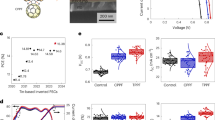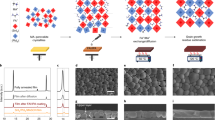Abstract
The development of tin-based devices with low toxicity is critical for the commercial viability of perovskite solar cells. However, because tin halide is a stronger Lewis acid, its crystallization rate is extremely fast, resulting in the formation of numerous defects that affect the device performance of tin-based perovskite solar cells. Herein, propylamine hydrobromide (PABr) was added to the perovskite precursor solution as an additive to passivate defects and fabricate more uniform and dense perovskite films. Because propylamine cations are too large to enter the perovskite lattices, they only exist at the grain boundary to passivate surface defects and promote crystal growth in a preferred orientation. The PABr additive raises the average short-circuit current density from 19.45 to 25.47 mA·cm−2 by reducing carrier recombination induced by defects. Furthermore, the device’s long-term illumination stability is improved after optimization, and the hysteresis effect is negligible. The addition of PABr results in a power conversion efficiency of 9.35%.
Similar content being viewed by others
References
M.A. Green, Y.J. Jiang, A.M. Soufiani, and A. Ho-Baillie, Optical properties of photovoltaic organic-inorganic lead halide perovskites, J. Phys. Chem. Lett., 6(2015), No. 23, p. 4774.
G.E. Eperon, S.D. Stranks, C. Menelaou, M.B. Johnston, L.M. Herz, and H.J. Snaith, Formamidinium lead trihalide: A broadly tunable perovskite for efficient planar heterojunction solar cells, Energy Environ. Sci., 7(2014), No. 3, p. 982.
S.R. Wang, X. Zhang, W.K. Zhu, et al., Lewis base manipulated crystallization for efficient tin halide perovskite solar cells, Appl. Surf. Sci., 602(2022), art. No. 154393.
P. You, G.J. Li, G.Q. Tang, J.P. Cao, and F. Yan, Ultrafast laser-annealing of perovskite films for efficient perovskite solar cells, Energy Environ. Sci., 13(2020), No. 4, p. 1187.
M.A. Green, A. Ho-Baillie, and H.J. Snaith, The emergence of perovskite solar cells, Nat. Photonics, 8(2014), No. 7, p. 506.
M. Pitaro, E.K. Tekelenburg, S.Y. Shao, and M.A. Loi, Tin halide perovskites: From fundamental properties to solar cells, Adv. Mater., 34(2022), No. 1, art. No. 2105844.
S. Gu, R.X. Lin, Q.L. Han, Y. Gao, H.R. Tan, and J. Zhu, Tin and mixed lead–tin halide perovskite solar cells: Progress and their application in tandem solar cells, Adv. Mater., 32(2020), No. 27, art. No. 1907392.
National Renewable Energy Laboratory (NREL), Best Research-Cell Efficiency Chart [2022-08 -18]. https://www.nrel.gov/pv/cell-efficiency.html?tdsourcetag=s_pcqq_aiomsg.
Z.B. Que, L. Chu, S.B. Zhai, et al., Self-assembled TiO2 hole-blocking layers for efficient perovskite solar cells, Int. J. Miner. Metall. Mater., 29(2022), No. 6, p. 1280.
J.P. Cao and F. Yan, Recent progress in tin-based perovskite solar cells, Energy Environ. Sci., 14(2021), No. 3, p. 1286.
C.C. Boyd, R. Cheacharoen, T. Leijtens, and M.D. McGehee, Understanding degradation mechanisms and improving stability of perovskite photovoltaics, Chem. Rev., 119(2019), No. 5, p. 3418.
R.L. Milot, M.T. Klug, C.L. Davies, et al., The effects of doping density and temperature on the optoelectronic properties of formamidinium tin triiodide thin films, Adv. Mater., 30(2018), No. 44, art. No. 1804506.
T.H. Wu, X. Liu, X.H. Luo, et al., Lead-free tin perovskite solar cells, Joule, 5(2021), No. 4, p. 863.
W.Y. Gao, P.Z. Li, J.B. Chen, C.X. Ran, and Z.X. Wu, Interface engineering in tin perovskite solar cells, Adv. Mater. Interfaces, 6(2019), No. 24, art. No. 1901322.
M. Aldamasy, Z. Iqbal, G.X. Li, et al., Challenges in tin perovskite solar cells, Phys. Chem. Chem. Phys., 23(2021), No. 41, p. 23413.
X. Zhang, S.R. Wang, W.K. Zhu, Z.Y. Cao, A.L. Wang, and F. Hao, The voltage loss in tin halide perovskite solar cells: Origins and perspectives, Adv. Funct. Mater., 32(2022), No. 8, art. No. 2108832.
B. Chen, S.R. Wang, X. Zhang, W.K. Zhu, Z.Y. Cao, and F. Hao, Reducing the interfacial voltage loss in tin halides perovskite solar cells, Chem. Eng. J., 445(2022), art. No. 136769.
W.S. Yang, J.H. Noh, N.J. Jeon, et al., High-performance photovoltaic perovskite layers fabricated through intramolecular exchange, Science, 348(2015), No. 6240, p. 1234.
K. Nishimura, M.A. Kamarudin, D. Hirotani, et al., Lead-free tin-halide perovskite solar cells with 13% efficiency, Nano Energy, 74(2020), art. No. 104858.
M. Konstantakou and T. Stergiopoulos, A critical review on tin halide perovskite solar cells, J. Mater. Chem. A, 5(2017), No. 23, p. 11518.
W.F. Yang, F. Igbari, Y.H. Lou, Z.K. Wang, and L.S. Liao, Tin halide perovskites: Progress and challenges, Adv. Energy Mater., 10(2020), No. 13, art. No. 1902584.
Z.H. Zhang, Z.C. Li, L.Y. Meng, S.Y. Lien, and P. Gao, Per-ovskite-based tandem solar cells: Get the most out of the sun, Adv. Funct. Mater., 30(2020), No. 38, art. No. 2001904.
X. Liu, T.H. Wu, X.H. Luo, et al., Lead-free perovskite solar cells with over 10% efficiency and size 1 cm2 enabled by solvent-crystallization regulation in a two-step deposition method, ACS Energy Lett., 7(2022), No. 1, p. 425.
Z. Zhang, M.A. Kamarudin, A.K. Baranwal, et al., Indent-free vapor-assisted surface passivation strategy toward tin halide perovskite solar cells, ACS Appl. Mater. Interfaces, 14(2022), No. 31, p. 36200.
A. Al-Ashouri, E. Köhnen, B. Li, et al., Monolithic perovskite/ silicon tandem solar cell with >29% efficiency by enhanced hole extraction, Science, 370(2020), No. 6522, p. 1300.
X. Liu, T.H. Wu, C.Y. Zhang, Y.Q. Zhang, H. Segawa, and L.Y. Han, Interface energy-level management toward efficient tin perovskite solar cells with hole-transport-layer-free structure, Adv. Funct. Mater., 31(2021), No. 50, art. No. 2106560.
W. Bumrungsan, K. Hongsith, V. Yarangsi, et al., Efficiency enhancement of Cs0.1(CH3NH3)0.9PbI3 perovskite solar cell by surface passivation using iso-butyl ammonium iodide, Int. J. Miner. Metall. Mater., 29(2022), No. 11, p. 1963.
Y.T. Xu, K.J. Jiang, P.C. Wang, et al., Highly oriented quasi-2D layered tin halide perovskites with 2-thiopheneethylam-monium iodide for efficient and stable tin perovskite solar cells, New J. Chem., 46(2022), No. 5, p. 2259.
Z.S. Dai, T. Lv, J. Barbaud, et al., Stable tin perovskite solar cells developed via additive engineering, Sci. China Mater., 64(2021), No. 11, p. 2645.
X. Liu, Y.B. Wang, T.H. Wu, et al., Efficient and stable tin per-ovskite solar cells enabled by amorphous-polycrystalline structure, Nat. Commun., 11(2020), No. 1, art. No. 2678.
M.M. Zhang, Z.G. Zhang, H.H. Cao, et al., Recent progress in inorganic tin perovskite solar cells, Mater. Today Energy, 23(2022), art. No. 100891.
G.X. Li, Z.H. Su, M. Li, et al., Ionic liquid stabilizing high-efficiency tin halide perovskite solar cells, Adv. Energy Mater., 11(2021), No. 32, art. No. 2101539.
X. Liu, T.H. Wu, J.Y. Chen, et al., Templated growth of FASnI3 crystals for efficient tin perovskite solar cells, Energy Environ. Sci., 13(2020), No. 9, p. 2896.
B.B. Yu, Z.H. Chen, Y.D. Zhu, et al., Heterogeneous 2D/3D tin-halides perovskite solar cells with certified conversion efficiency breaking 14%, Adv. Mater., 33(2021), No. 36, art. No. 2102055.
H.S. Li, X.Y. Jiang, Q. Wei, et al., Low-dimensional inorganic tin perovskite solar cells prepared by templated growth, Angew. Chem. Int. Ed., 60(2021), No. 30, p. 16330.
M.A. Kamarudin, S.R. Sahamir, K. Nishimura, et al., Suppression of defect and trap density through dimethylammonium-substituted tin perovskite solar cells, ACS Mater. Lett., 4(2022), No. 9, p. 1855.
F.D. Gu, C.B. Wang, Z.R. Zhao, et al., Tin(II) acetylacetonate as a new type of tin compensator additive for tin-based per-ovskite solar cells, ACS Appl. Mater. Interfaces, 13(2021), No. 37, p. 44157.
Z. Zhang, M.A. Kamarudin, A.K. Baranwal, et al., Sequential passivation for lead-free tin perovskite solar cells with high efficiency, Angew. Chem. Int. Ed., 61(2022), No. 42, art. No. 202210101.
S.R. Wang, L. Yan, W.K. Zhu, et al., Suppressing the formation of tin vacancy yields efficient lead-free perovskite solar cells, Nano Energy, 99(2022), art. No. 107416.
H.J. Yan, B.W. Wang, X.F. Yan, et al., Efficient passivation of surface defects by lewis base in lead-free tin-based perovskite solar cells, Mater. Today Energy, 27(2022), art. No. 101038.
Z. Zhang, L. Wang, A.K. Baranwal, et al., Enhanced efficiency and stability in Sn-based perovskite solar cells by trimethylsilyl halide surface passivation, J. Energy Chem., 71(2022), p. 604.
E. Jokar, C.H. Chien, A. Fathi, M. Rameez, Y.H. Chang, and E.W.G. Diau, Slow surface passivation and crystal relaxation with additives to improve device performance and durability for tin-based perovskite solar cells, Energy Environ. Sci., 11(2018), No. 9, p. 2353.
C. Liu, J. Tu, X.T. Hu, et al., Enhanced hole transportation for inverted tin-based perovskite solar cells with high performance and stability, Adv. Funct. Mater., 29(2019), No. 18, art. No. 1808059.
E. Jokar, H.S. Chuang, C.H. Kuan, et al., Slow passivation and inverted hysteresis for hybrid tin perovskite solar cells attaining 13.5% via sequential deposition, J. Phys. Chem. Lett., 12(2021), No. 41, p. 10106.
B.H. Chang, B. Li., Z.X. Wang, et al., Efficient bulk defect suppression strategy in FASnI3 perovskite for photovoltaic performance enhancement, Adv. Funct. Mater., 32(2022), No. 12, art. No. 2107710.
P.J. Zhao, B.J. Kim, and H.S. Jung, Passivation in perovskite solar cells: A review, Mater. Today Energy, 7(2018), p. 267.
Q.D. Tai, X.Y. Guo, G.Q. Tang, et al., Antioxidant grain passivation for air-stable tin-based perovskite solar cells, Angew. Chem. Int. Ed., 58(2019), No. 3, p. 806.
J.Y. Kim, J.W. Lee, H.S. Jung, H. Shin, and N.G. Park, High-efficiency perovskite solar cells, Chem. Rev., 120(2020), No. 15, p. 7867.
Y. Zhang, Y. Li, L. Zhang, et al., Propylammonium chloride additive for efficient and stable FAPbI3 perovskite solar cells, Adv. Energy Mater., 11(2021), No. 47, art. No. 2102538.
D.S. Yao, C.M. Zhang, S.L. Zhang, et al., 2D–3D mixed organic-inorganic perovskite layers for solar cells with enhanced efficiency and stability induced by n-propylammonium iodide additives, ACS Appl. Mater. Interfaces, 11(2019), No. 33, p. 29753.
D.D. Wu, P.C. Jia, W.T. Bi, et al., Enhanced performance of tin halide perovskite solar cells by addition of hydrazine mono-hydrobromide, Org. Electron., 82(2020), art. No. 105728.
P.C. Jia, L. Qin, D. Zhao, et al., The trapped charges at grain boundaries in perovskite solar cells, Adv. Funct. Mater., 31(2021), No. 49, art. No. 2107125.
C.X. Ran, W.Y. Gao, J.R. Li, et al., Conjugated organic cations enable efficient self-healing FASnI3 solar cells, Joule, 3(2019), No. 12, p. 3072.
Acknowledgements
This work was supported by the Talent Fund of Beijing Jiaotong University (No. 2019RC058) and the National Natural Science Foundation of China (Nos. 62205013, 62075009, 62275013, and 12274020).
Author information
Authors and Affiliations
Corresponding authors
Ethics declarations
The authors disclose no relevant relationship.
Supplementary Information
Rights and permissions
About this article
Cite this article
Li, X., Jia, P., Meng, F. et al. Propylamine hydrobromide passivated tin-based perovskites to efficient solar cells. Int J Miner Metall Mater 30, 1965–1972 (2023). https://doi.org/10.1007/s12613-023-2604-y
Received:
Revised:
Accepted:
Published:
Issue Date:
DOI: https://doi.org/10.1007/s12613-023-2604-y




